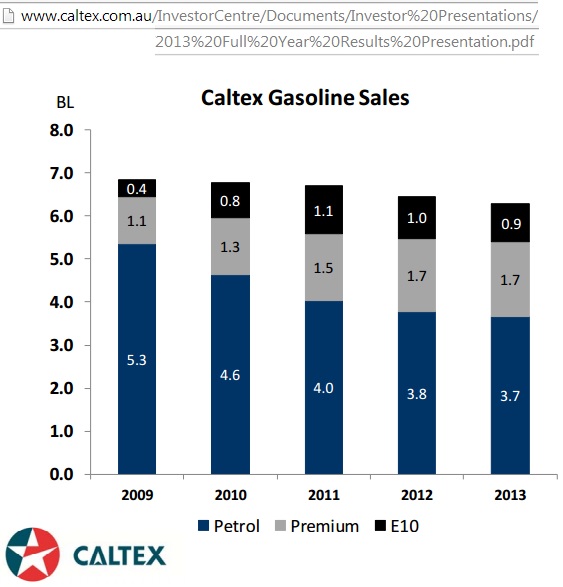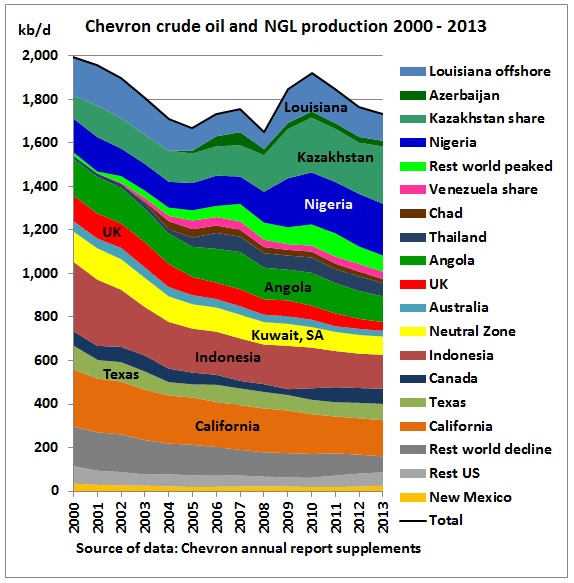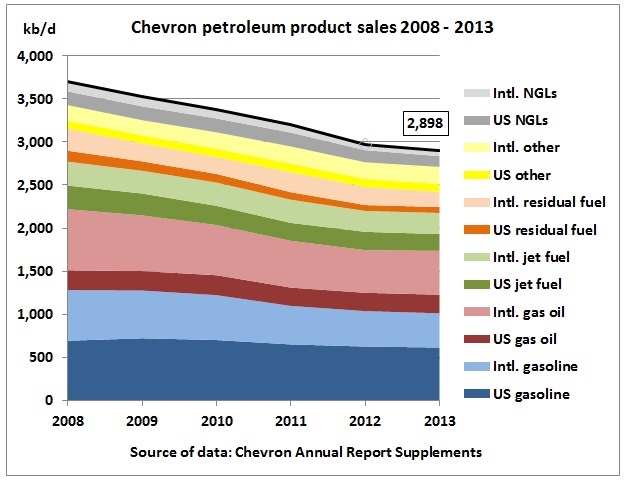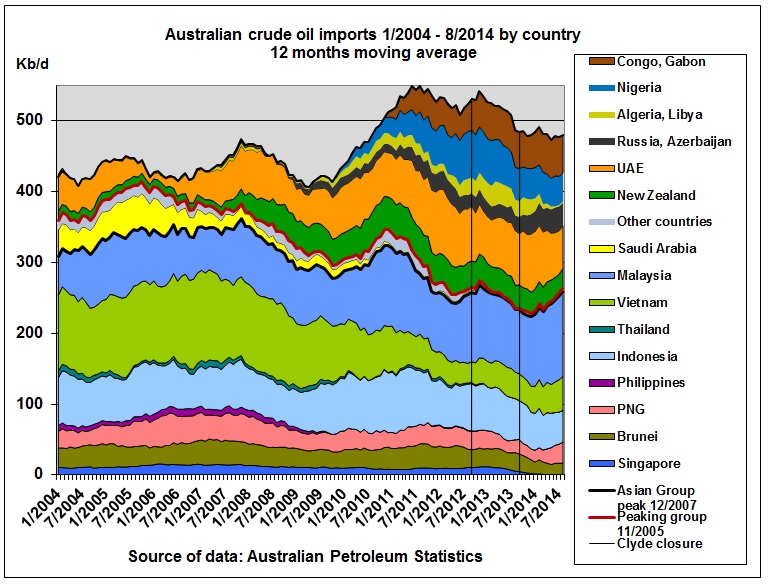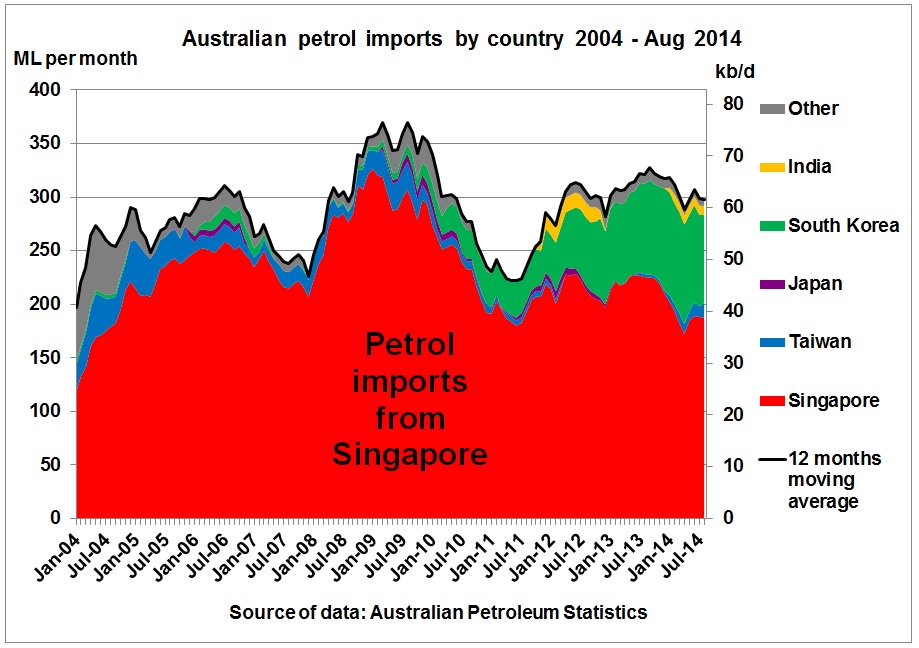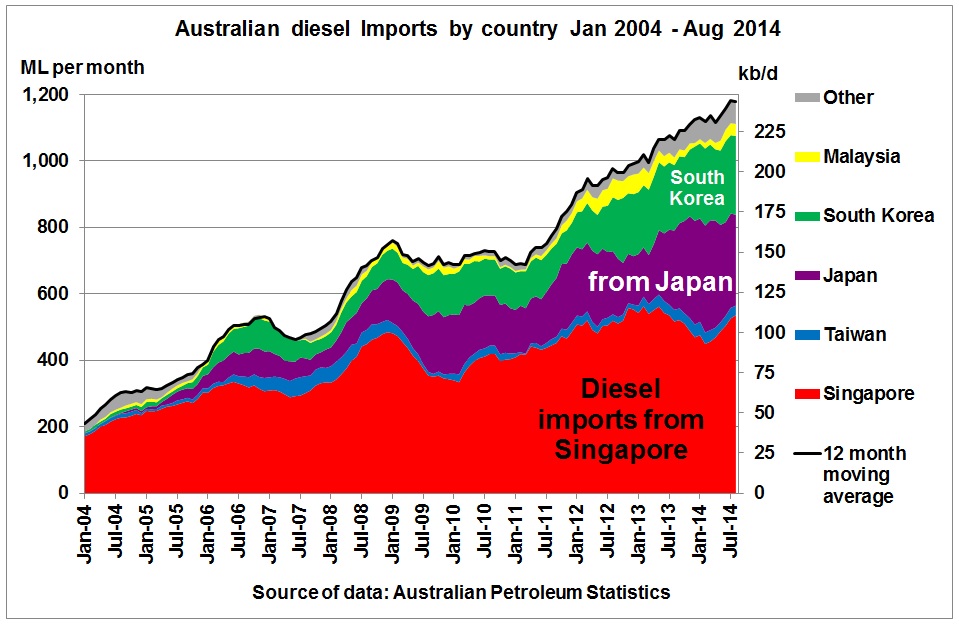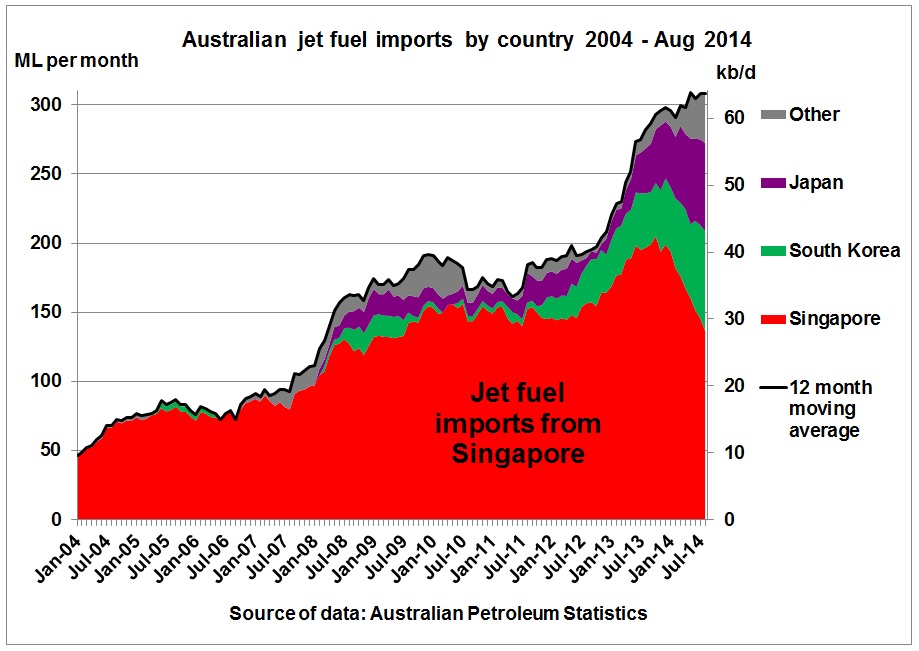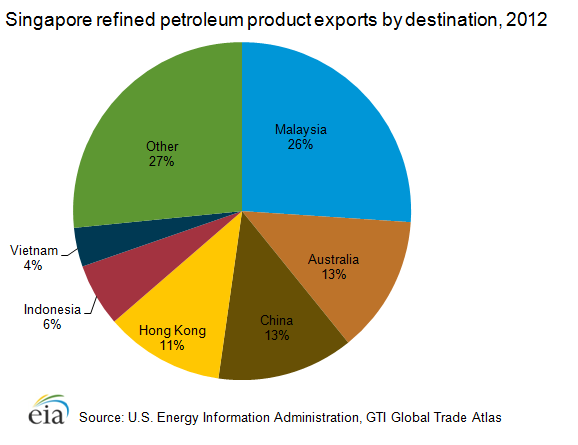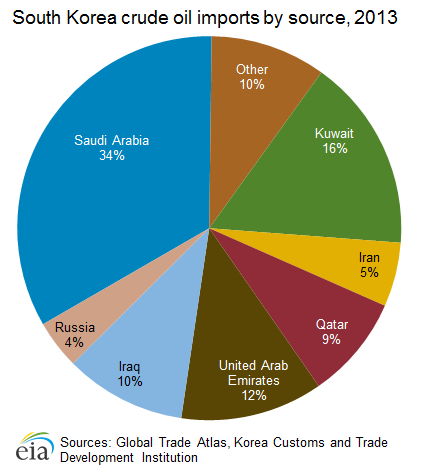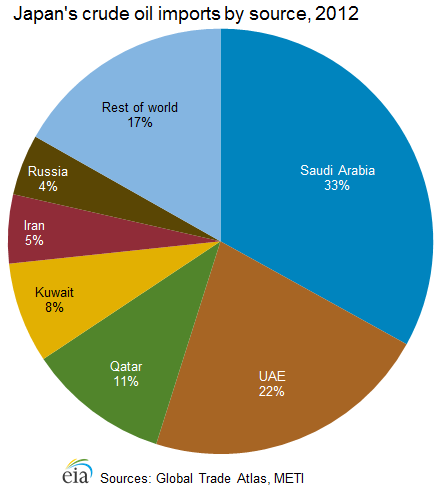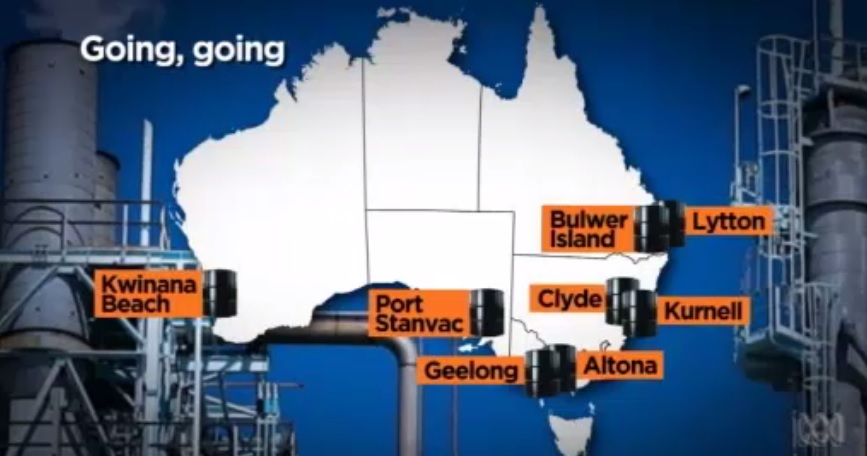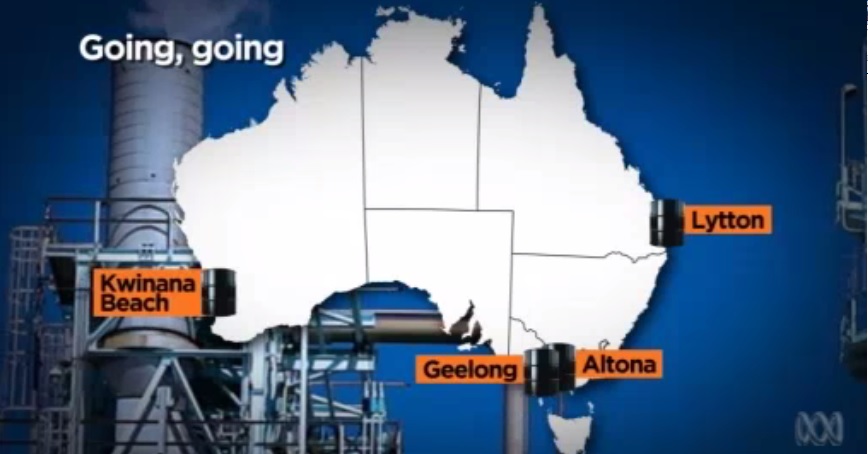As already announced in July 2012, Sydney’s Caltex refinery (135 kb/d) has now closed, replaced by a fuel import terminal, holding approximately 45 to 60 days of inventory (Caltex Annual Report 2013, p 36). 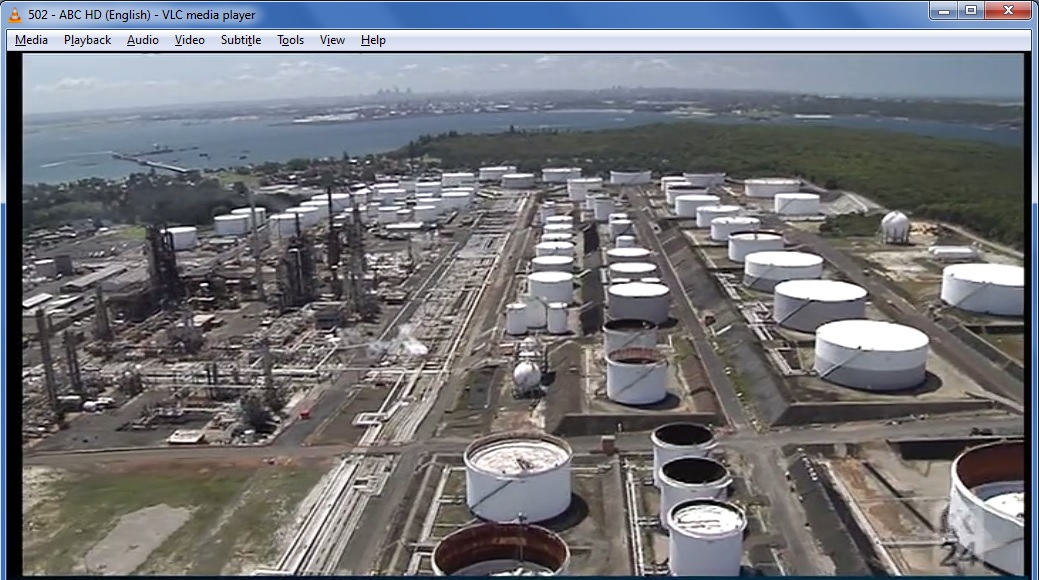
Fig 1: Kurnell refinery in Sydney
Caltex Refinery Performance
The segment “Refining and Supply” didn’t make money, as shown in this graph from the annual report 2013: 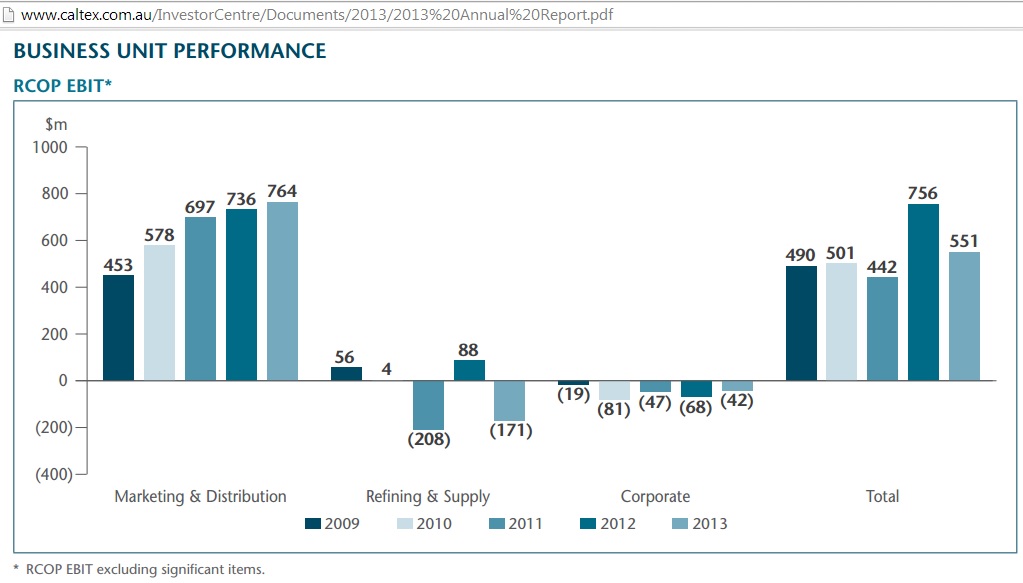
Fig 2: Replacement cost of sales operating profit, earnings before interest and tax
(excluding significant items)
http://www.caltex.com.au/InvestorCentre/Documents/2013/2013%20Annual%20Report.pdf
Fig 3: Caltex Gasoline Sales declined by 1.8% pa
Fig 4: Caltex Diesel sales growth was 6.1% pa and Jet Fuel 9.2%
Total growth of all fuels was 2.8%. Above graphs are from this file:
In 2012, Managing Director and CEO Julian Segal announced that growing demandfor fuels would be met by fuel imports from Chevron.
http://www.acapma.com.au/articles/caltex-announces-supply-chain-restructuring.html
Chevron
Let’s have a look how Chevron is doing.
Fig 5: Chevron’s crude oil and NGL production by country
http://www.chevron.com/news/publications/
Fig 6: Chevron’s petroleum sales
So that’s all in long term decline
Security of supplies: crude vs fuel imports
15/10/2014
Andrew Brewer (Caltex Supply Chain Operations Manager): “the main issue with relying on overseas imports, especially in the majority of fuels supply, is of course the security of fuel. We are relying on good relationship in terms of our trade partners, access to other good markets and history tells us that may not always be the case”
http://www.abc.net.au/news/2014-10-14/caltex-australias-sydney-oil-refinery-is-closed/5813946
The main factor of security is the diversity of crude oil/fuel supplies.
Fig 7: Australian crude oil imports by country
We see that Australian refineries are doing a good job of drawing crude oil from diverse sources, around 10 countries or groups of countries. The vertical lines denote the period of 12 month moving average which cover the closure of the Clyde refinery.
Fig 9: Diesel imports have been skyrocketing
Fig 10: Aviation turbine fuel imports
All data are from here: http://www.bree.gov.au/publications/australian-petroleum-statistics
So fuel imports are basically dependent on only 3 countries: Singapore, South Korea and Japan, much less diverse than crude oil imports. Obviously, fuel imports from Singapore have bumped into a refinery capacity limit there. Growth came only from South Korea and Japan.
Australia competes with other neighbours in Asia:
Fig 11: Singapore fuel exports by destination
Middle East dependency
Another factor of security is a low dependency on the Middle East. As we can see from Fig 5, Australian crude imports from UAE are just 13% of the total. But fuel imports come from refineries which rely heavily on crude imports from the ME.
Fig 12: Singapore crude imports by origin
http://www.eia.gov/countries/cab.cfm?fips=sn
Fig 13: South Korea is 86% dependent on Middle East
http://www.eia.gov/countries/cab.cfm?fips=ks
Fig 14: Japan is 79% dependent on the Middle East
http://www.eia.gov/countries/cab.cfm?fips=ja
Iraq dependency
Fig 15: More than half of Iraq’s crude exports go to Asia
http://www.eia.gov/countries/cab.cfm?fips=IZ
Australian refineries going…..
Fig 14: Australian refineries 2002
Fig 15: Australian refineries 2015
http://www.abc.net.au/news/2014-10-14/caltex-australias-sydney-oil-refinery-is-closed/5813946
……Gone:
Stanvac 1963-2003, Clyde 1920s-2012, Kurnell 1956-2014, Bulwer 1965-2015
Energy Green Paper (September 2014)
The Energy Green Paper recently released by the federal government hasn’t done any of the above updated analysis.
On page 52 we find:
“Australia has six major oil refineries. One of the largest, Kurnell in Sydney, is scheduled to close in the second half of 2014. Bulwer Island in Brisbane is to close in 2015. These closures reflect the comparative disadvantages of Australian refineries, including age, small size, and labour and construction costs. The NESA will monitor this declining capacity, assess the potential impacts and provide early warning if it is likely to become a problem.
Supply is maintained using domestic refineries, crude oil and refined product import terminals, and other stockholding facilities. Most of the supply chain is mobile, with about one-third of domestic supply at sea (at any one time) using a number of diversified and flexible shipping routes. Some 53 per cent of product supply comes from Singapore. Mitsubishi has announced that it will build a diesel import terminal at Port Bonython in South Australia, thereby increasing Australia’s fuel supply options.”
http://ewp.industry.gov.au/sites/prod2.ewp.industry.gov.au/files/egp/energy_green_paper.pdf
National Energy Security Assessment
Let’s have a look at NESA (National Energy Security Assessment).
http://www.industry.gov.au/Energy/EnergySecurity/nesa/Pages/default.aspx
The latest report is from December 2011.
“The overall assessment for liquid fuel security is largely unchanged since the release of the last NESA in 2009 and is assessed as high trending to moderate in the long term. There have been a number of notable events in the liquid fuel sector since that time, such as a return to high global oil prices, the political crisis in Libya, the Montara and Macondo oil spills, natural disasters such as the Queensland cyclones and floods, and the recent announcement of the conversion of Shell’s Clyde refinery into an import terminal. However, while each of these events has been significant in its own right, none have had a material impact on Australia’s liquid fuel security.
Fig 16: NESA’s 2011 summary of liquid fuel security
Despite this, risks remain in the global market. Factors such as a major political crisis in a key production centre, higher than expected global demand growth, a weakening of the Australian or global economy or a shortfall in investment in new production capacity globally could all have a significant impact on global liquid fuel markets and prices, and would potentially lead to a change in the assessment of Australia’s liquid fuel security.
Finally, growing Australian imports are placing compliance pressures on Australia’s ‘90 day’ stockholding obligation under the International Energy Agency (IEA) treaty” p.8
No action has been taken on the 90 day stockholding requirement. One day this will be regretted.
In NESA’s report we see an endless chain of arguments going into many directions without any concluding, concrete proposals how to reduce Australia’s dependency on crude oil or petroleum product imports. The Energy Green Paper has not updated this assessment although the geopolitical situation in the Middle East has markedly deteriorated (religious war) and 2 more refineries are closing. We can have no confidence that an “early warning” will be given by the government BEFORE problems occur.
Conclusion:
Australia has good relationships to Singapore, South Korea and Japan (except for the issue of whaling in the Southern Ocean). But the relationships between Middle East countries is now the main issue as the civil wars in Syria and Iraq will undoubtedly impact on oil exports from this part of the world. US shale oil will not change this. Nor did it stop Caltex from closing Kurnell.
Related and previous posts
9/4/2014
Why the closure of BP’s Brisbane Bulwer refinery reduces Australia’s energy security
23/2/2014
Geelong refinery sold as Shell’s oil production continues to decline
28/8/2013
Chevron’s oil production, sales decline by 5%
27/7/2012
After Sydney’s refinery closure: Caltex to import fuel from Chevron’s shrinking sales
13/4/2011
Australia’s fuel import vulnerability increases as Sydney’s Clyde refinery is closing
